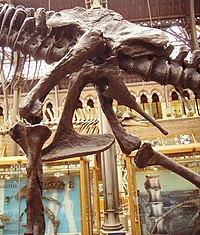Saurischia
| Saurischians Temporal range: Late Triassic–Late Cretaceous,
| |
|---|---|

| |
| Tyrannosaurus rex saurischian pelvis and hind limbs (left side). | |
| Scientific classification | |
| Kingdom: | |
| Phylum: | |
| Class: | |
| Subclass: | |
| Infraclass: | |
| Magnorder: | |
| Superorder: | |
| Order: | Saurischia* Seeley, 1888
|
| Suborders | |
Saurischia (Template:PronEng saw-RIS-kee-ə, from the Greek sauros (σαυρος) meaning 'lizard' and ischion (ισχιον) meaning 'hip joint')[1] is one of the two orders, or basic divisions, of dinosaurs. In 1888, Harry Seeley classified dinosaurs into two orders, based on their hip structure.[2] Saurischians ('lizard-hipped') are distinguished from the ornithischians ('bird-hipped') by retaining the ancestral configuration of bones in the hip.
All carnivorous dinosaurs (the theropods) are saurischians, as are one of the two primary lineages of herbivorous dinosaurs, the sauropodomorphs. At the end of the Cretaceous Period, all non-avian saurischians became extinct. This is referred to as the Cretaceous-Tertiary extinction event. Avians (modern birds), as direct descendants of one group of saurischian dinosaurs, are considered to be a sub-clade of saurischian dinosaurs in phylogenetic classification.
Description
Saurischians are distinguished from ornithischians by their three-pronged pelvic structure, with the pubis pointed forward. The ornithischians pelvis is arranged with the pubis rotated backward, parallel with the ischium, often also with a forward-pointing process, giving a four-pronged structure.
The ornithischian hip structure is superficially similar to that of birds, which led Seeley to name them "bird-hipped dinosaurs," though he did not propose any specific relationship with birds. He termed saurischians "lizard-hipped" dinosaurs because they retained the ancestral hip anatomy also found in modern lizards.
However, as later study revealed, the hip structure possessed by modern birds actually evolved independently from the "lizard-hipped" saurischians (specifically, a sub-group of saurischians called the Maniraptora) in the Jurassic Period. In this example of convergent evolution, birds developed hips oriented similar to the earlier ornithischian hip anatomy, in both cases possibly as an adaptation to a herbivorous or omnivorous diet.
Classification

In his paper naming the two groups, Seeley reviewed previous classification schemes put forth by other paleontologists to divide up the traditional Order Dinosauria. He preferred one that had been put forward by Othniel Charles Marsh in 1878, which divided dinosaurs into four Orders: Sauropoda, Theropoda, Ornithopoda, and Stegosauria (these names are still used today in much the same way to refer to suborders or clades within Saurischia and Ornithischia).[2]
Seeley, however, wanted to formulate a classification that would take into account a single primary difference between major dinosaurian groups based on a characteristic that also differentiated them from other reptiles. He found this in the configuration of the hip bones, and found that all four of Marsh's orders could be divided neatly into two major groups based on this feature. He placed the Stegosauria and Ornithopoda in the Ornithischia, and the Theropoda and Sauropoda in the Saurischia. Furthermore, Seeley used this major difference in the hip bones, along with many other noted differences between the two groups, to argue that "dinosaurs" were not a natural grouping at all, but rather two distinct orders that had arisen independently from more primitive archosaurs.[2] This concept that "dinosaur" was an outdated term for two distinct orders lasted many decades in the scientific and popular literature, and it was not until the 1960s that scientists began to again consider the possibility that saurischians and ornithischians were more closely related to each other than they were to other archosaurs.
Although his concept of a paraphyletic Dinosauria is no longer accepted by most paleontologists, Seeley's basic division of the two dinosaurian groups has stood the test of time, and has been supported by modern cladistic analysis of relationships among dinosaurs.[3] One alternate hypothesis challenging Seeley's classification was proposed by Robert T. Bakker in his 1986 book The Dinosaur Heresies. Bakker's classification separated the theropods into their own group and placed the two groups of herbivorous dinosaurs (the sauropodomorphs and ornithischians) together in a separate group he named the Phytodinosauria ('plant dinosaurs').[4] The Phytodinosauria hypothesis was based partly on the supposed link between ornithischians and prosauropods, and the idea that the former had evolved directly from the later, possibly by way of an enigmatic family that seemed to possess characters of both groups, the segnosaurs.[5] However, it was later found that segnosaurs were actually an unusual type of herbivorous theropod saurischians closely related to birds, and the Phytodinosauria hypothesis fell out of favor.
Taxonomy
- Order Saurischia
- Eoraptor
- Guaibasaurus
- Infraorder Herrerasauria
- Suborder Sauropodomorpha
- Infraorder Prosauropoda
- Infraorder Sauropoda
- Suborder Theropoda
- Infraorder Carnosauria
- Infraorder Ceratosauria
- Infraorder Deinonychosauria
- Infraorder Ornithomimosauria
- Infraorder Oviraptorosauria
Additionally, the genera Teyuwasu and Agnosphitys may represent early saurischians, or more primitive non-dinosaurs.
Phylogeny
The following cladogram is adapted from Weishampel et al., 2004.[3]
| Saurischia | |
References
- ^ OED
- ^ a b c Seeley, H.G. (1888). "On the classification of the fossil animals commonly named Dinosauria." Proceedings of the Royal Society of London, 43: 165-171.
- ^ a b Weishampel, David B.; Dodson, Peter; Osmólska, Halszka (eds.) (2004). The Dinosauria, Second Edition. University of California Press., 861 pp.
- ^ Bakker, R.T. (1986). The Dinosaur Heresies. New York: William Morrow. p. 203. ISBN 0-14-010055-5.
- ^ Paul, G.S. (1988). Predatory Dinosaurs of the World, a Complete Illustrated Guide. New York: Simon and Schuster. 464 p.



